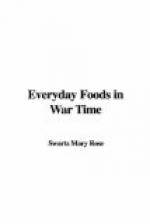Another good rule is to spend no more for meat, fish, and eggs than for milk, and as much for fruits and vegetables as for meat, fish, and eggs. Families very commonly spend as much as one-third of the food money for meat; and, while they may secure a full third of their protein, iron, and phosphorus in this way, they may not get more than a sixth of their fuel and almost no calcium. Three quarts of milk at fourteen cents a quart will yield about 2,000 calories. For an expenditure of forty-two cents for beef as free from waste as milk, we would pay perhaps thirty-two cents per pound. A pound and a quarter of lean beef would yield about 1,000 calories. So as fuel alone the milk would be twice as cheap as the meat. Three quarts of milk would yield almost if not quite as much protein as the meat and a liberal supply of calcium to offset the iron furnished by the meat. Everything considered, then, milk is a better investment than meat. The same is true of some of the other foods which supply protein in the diet such as dry peas and beans; cheese and peanut butter are at least twice as valuable nutritionally as beef. The domestic problem is to make palatable dishes from these foods. This requires time and patience. The cook must not get discouraged if the first trial does not bring marked success. The rest of the family should count it their “bit” to eat valiantly until they can eat joyfully.
CHAPTER IV
THE POTATO AND ITS SUBSTITUTES
Never did it seem truer that “blessings brighten as they take their flight” than when the potato went off the market or soaring prices put it out of reach in the winter of 1917. “How shall I plan my meals without it?” was the housewife’s cry. “How shall I enjoy my meals without it?” said all the millions of potato eaters who immediately forgot that there was still a large number of foods from which they might extract some modicum of enjoyment.




